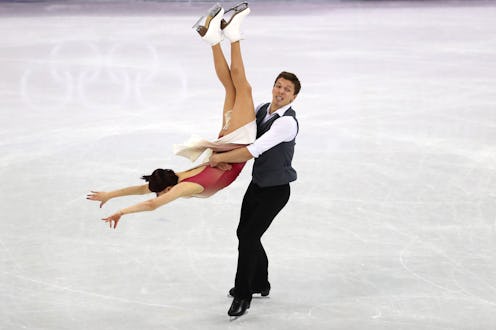Life
The 5 Scariest Figure Skating Tricks Athletes Can Phyiscally Pull Off

Figure skating is not for people afraid of pain. The skaters at PyeongChang's Winter Olympics make their routines look fluid and easy as taking a twirl round the kitchen floor, but some figure skating routines are dangerous — and among the standard moves are some so terrifying that it's amazing that they count as entertainment. From triple lutzes to throw quad salchows, the vocabulary seems innocuous and charming, but the figure skating tricks behind them are serious business.
Some skating moves have been outlawed for being far too dangerous, including backflips on the ice, which are possible but deemed so risky that they're illegal in international competitions. And serious physical risk is a part of the deal — as Adam Rippon, the Olympic figure skater at PyeongChang who dislocated his shoulder at the National Championships, put it back into place and simply kept skating, can attest. However, that doesn't mean that the legal moves are any less challenging — or, when broken down into their component parts, any less spectacularly scary to onlookers. If you see a figure skater land any of these five moves, they've risked life and limb in the pursuit of excellence in their sport — and probably fallen down a lot while trying.
1The Triple Axel
This one's the headliner at the moment, because America's Mirai Nagasu is the first U.S. skater, and only the third woman in the world, to have landed a triple axel at the Olympics. She nailed it in the team skating event at PyeongChang, helping the American team land a bronze medal and achieving a season-best score. It's notoriously difficult; Tonya Harding made history by performing the jump in 1991, then couldn't pull it off again at an Olympics. It involves a full three and a half turns in the air, and is extremely tricky to perform without falling.
2The Quadruple Jump
While quadruple jumps were largely unknown in elite figure skating even two Olympics ago, they've now become ubiquitous among male figure-skating routines — and a Deadspin investigation in 2014 wondered if they were the most difficult thing that a human figure skater could actually attempt. Quadruple jumps, landed successfully, include a full four turns in the air; a quadruple axel, by contrast, is 4 and a half turns, and nobody has ever managed to land this jump in a world competition. Nathan Chen, the U.S. skater at PyeongChang, has a routine that comprises quadruple jumps in five different ways —salchow, loop, toe loop, flip, and lutz — which makes him a) the first of his kind and b) certifiably amazing.
3The Quintuple Jump
Yuzuru Hanyu, who was world champion at the last figure skating championships, believes that a quintuple jump is physically possible, requiring a huge increase in speed and lift — but it remains to be seen whether anybody can actually perform one in competition. Scientific American consulted experts on this in 2014 and noted two obstacles: the amount of time that the skater would need to spend in the air (0.75 seconds, as opposed to around 0.70 for quads), and the sheer force they'd experience in their bodies when landing. WIRED also points out that figure skaters have to rotate at greater than 400 rpm to land a quadruple, and going faster than that might not be possible. The strength and resilience required to do quadruple jumps in competition is already tremendous, but quintuples could simply be beyond the range of human effort.
4The Triple Lutz
Unlike axel jumps, lutz jumps require a skater to launch themselves into the air using their toe pick, the bit at the end of their skate that provides grip. This is where it gets complicated, so bear with me: figure skaters' skates actually have two small blades, an "inside" and an "outside", with a hollow in between. Doing a lutz jump means taking off from your toe on the outside edge of one foot and landing, after twirling in the air, on the outside edge of the other foot. If this sounds brutally difficult, it is. South Korea's Yuna Kim, who lit the cauldron at the PyeongChang Games, is famous for her triple lutzes, because she somehow makes them look easy.
5The Throw Quad Salchow
If pairs figure skating seems intensely dangerous to you — there is a required element called a "death spiral" — then you ain't seen nothing yet. The throw quad salchow is regarded as one of the most dangerous things you can do in a pair on ice, and has only been landed relatively rarely in competitions. As opposed to quad salchows in individual skating, where skaters take four turns in the air going counterclockwise, throw quad salchows are performed when the female partner is thrown into four turns by the male partner and has to land perfectly. Quadruple turns in the air are hard enough on your own; being thrown into one by somebody else is hugely tricky.
Nobody said earning a figure skating gold was easy — but when you get into the technical details of what's necessary to find a place on the podium, the difficulty starts to look slightly otherworldly. Underneath those sparkles are some extremely hardened adrenalin junkies.